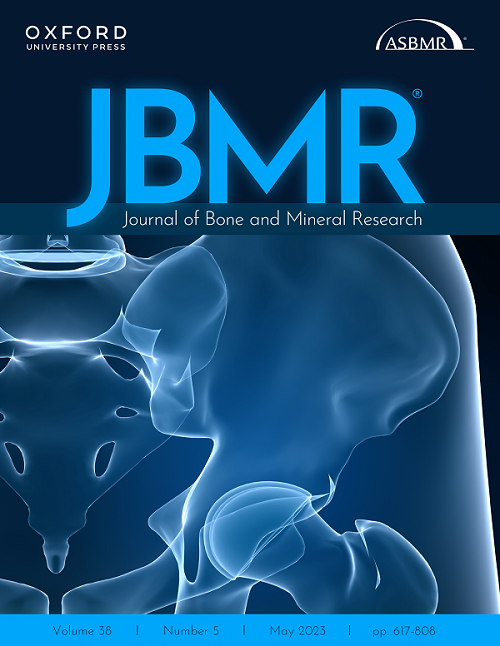下载PDF
{"title":"GNA11 Variants Identified in Patients with Hypercalcemia or Hypocalcemia","authors":"Sarah A. Howles, Caroline M. Gorvin, Treena Cranston, Angela Rogers, Anna K. Gluck, Hannah Boon, Kate Gibson, Mushtaqur Rahman, Allen Root, M. Andrew Nesbit, Fadil M. Hannan, Rajesh V. Thakker","doi":"10.1002/jbmr.4803","DOIUrl":null,"url":null,"abstract":"<p>Familial hypocalciuric hypercalcemia type 2 (FHH2) and autosomal dominant hypocalcemia type 2 (ADH2) are due to loss- and gain-of-function mutations, respectively, of the <i>GNA11</i> gene that encodes the G protein subunit Gα11, a signaling partner of the calcium-sensing receptor (CaSR). To date, four probands with FHH2-associated Gα11 mutations and eight probands with ADH2-associated Gα11 mutations have been reported. In a 10-year period, we identified 37 different germline <i>GNA11</i> variants in >1200 probands referred for investigation of genetic causes for hypercalcemia or hypocalcemia, comprising 14 synonymous, 12 noncoding, and 11 nonsynonymous variants. The synonymous and noncoding variants were predicted to be benign or likely benign by in silico analysis, with 5 and 3, respectively, occurring in both hypercalcemic and hypocalcemic individuals. Nine of the nonsynonymous variants (Thr54Met, Arg60His, Arg60Leu, Gly66Ser, Arg149His, Arg181Gln, Phe220Ser, Val340Met, Phe341Leu) identified in 13 probands have been reported to be FHH2- or ADH2-causing. Of the remaining nonsynonymous variants, Ala65Thr was predicted to be benign, and Met87Val, identified in a hypercalcemic individual, was predicted to be of uncertain significance. Three-dimensional homology modeling of the Val87 variant suggested it was likely benign, and expression of Val87 variant and wild-type Met87 Gα11 in CaSR-expressing HEK293 cells revealed no differences in intracellular calcium responses to alterations in extracellular calcium concentrations, consistent with Val87 being a benign polymorphism. Two noncoding region variants, a 40bp-5'UTR deletion and a 15bp-intronic deletion, identified only in hypercalcemic individuals, were associated with decreased luciferase expression in vitro but no alterations in <i>GNA11</i> mRNA or Gα11 protein levels in cells from the patient and no abnormality in splicing of the <i>GNA11</i> mRNA, respectively, confirming them to be benign polymorphisms. Thus, this study identified likely disease-causing <i>GNA11</i> variants in <1% of probands with hypercalcemia or hypocalcemia and highlights the occurrence of <i>GNA11</i> rare variants that are benign polymorphisms. © 2023 The Authors. <i>Journal of Bone and Mineral Research</i> published by Wiley Periodicals LLC on behalf of American Society for Bone and Mineral Research (ASBMR).</p>","PeriodicalId":185,"journal":{"name":"Journal of Bone and Mineral Research","volume":"38 6","pages":"907-917"},"PeriodicalIF":5.1000,"publicationDate":"2023-03-27","publicationTypes":"Journal Article","fieldsOfStudy":null,"isOpenAccess":false,"openAccessPdf":"https://onlinelibrary.wiley.com/doi/epdf/10.1002/jbmr.4803","citationCount":"2","resultStr":null,"platform":"Semanticscholar","paperid":null,"PeriodicalName":"Journal of Bone and Mineral Research","FirstCategoryId":"3","ListUrlMain":"https://onlinelibrary.wiley.com/doi/10.1002/jbmr.4803","RegionNum":1,"RegionCategory":"医学","ArticlePicture":[],"TitleCN":null,"AbstractTextCN":null,"PMCID":null,"EPubDate":"","PubModel":"","JCR":"Q1","JCRName":"ENDOCRINOLOGY & METABOLISM","Score":null,"Total":0}
引用次数: 2
引用
批量引用
Abstract
Familial hypocalciuric hypercalcemia type 2 (FHH2) and autosomal dominant hypocalcemia type 2 (ADH2) are due to loss- and gain-of-function mutations, respectively, of the GNA11 gene that encodes the G protein subunit Gα11, a signaling partner of the calcium-sensing receptor (CaSR). To date, four probands with FHH2-associated Gα11 mutations and eight probands with ADH2-associated Gα11 mutations have been reported. In a 10-year period, we identified 37 different germline GNA11 variants in >1200 probands referred for investigation of genetic causes for hypercalcemia or hypocalcemia, comprising 14 synonymous, 12 noncoding, and 11 nonsynonymous variants. The synonymous and noncoding variants were predicted to be benign or likely benign by in silico analysis, with 5 and 3, respectively, occurring in both hypercalcemic and hypocalcemic individuals. Nine of the nonsynonymous variants (Thr54Met, Arg60His, Arg60Leu, Gly66Ser, Arg149His, Arg181Gln, Phe220Ser, Val340Met, Phe341Leu) identified in 13 probands have been reported to be FHH2- or ADH2-causing. Of the remaining nonsynonymous variants, Ala65Thr was predicted to be benign, and Met87Val, identified in a hypercalcemic individual, was predicted to be of uncertain significance. Three-dimensional homology modeling of the Val87 variant suggested it was likely benign, and expression of Val87 variant and wild-type Met87 Gα11 in CaSR-expressing HEK293 cells revealed no differences in intracellular calcium responses to alterations in extracellular calcium concentrations, consistent with Val87 being a benign polymorphism. Two noncoding region variants, a 40bp-5'UTR deletion and a 15bp-intronic deletion, identified only in hypercalcemic individuals, were associated with decreased luciferase expression in vitro but no alterations in GNA11 mRNA or Gα11 protein levels in cells from the patient and no abnormality in splicing of the GNA11 mRNA, respectively, confirming them to be benign polymorphisms. Thus, this study identified likely disease-causing GNA11 variants in <1% of probands with hypercalcemia or hypocalcemia and highlights the occurrence of GNA11 rare variants that are benign polymorphisms. © 2023 The Authors. Journal of Bone and Mineral Research published by Wiley Periodicals LLC on behalf of American Society for Bone and Mineral Research (ASBMR).


